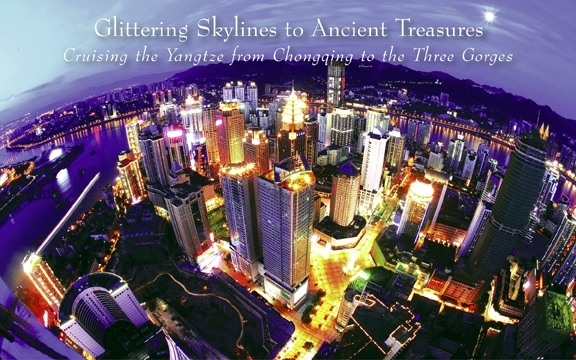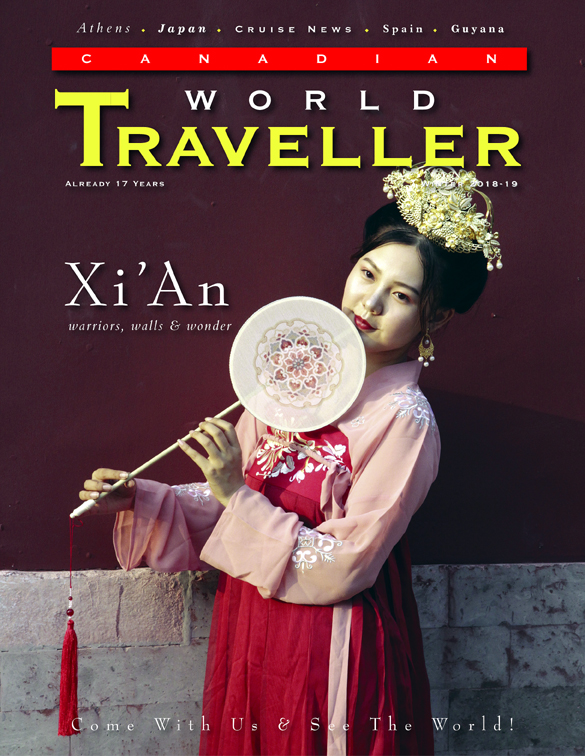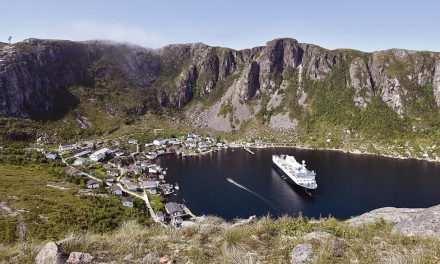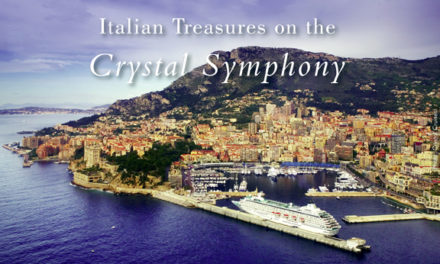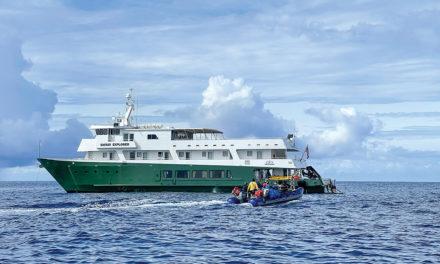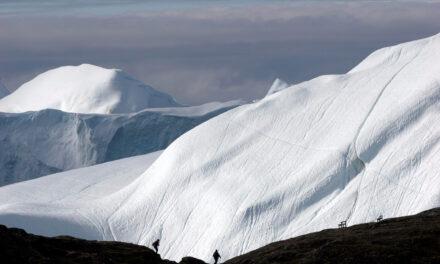Cruise
Glittering Skylines to Ancient Treasures
Cruising the Yangtze from Chongqing to the Three Gorges
Article and Photography by Jennifer Merrick

“China has changed so much in the last 20 years,” I kept hearing before my trip. I was told of megacities, seas of skyscrapers and high-speed trains in a country modernizing at breakneck pace.
And they were right. “How could I not have heard about this place before?” was my question when we first arrived in Chongqing. Located in the country’s southwest, this massive metropolis was where our four-day cruise along the Yangtze River would set sail.
The city’s night view mesmerized us. Its brightly lit bridges that crossed the Yangtze and Jialing Rivers, and the glittering skyscrapers and modern architecture gave any of the world’s more famous city skylines a run for their money. Known for mountains, spicy cuisine and beautiful women, Chongqing is one of the fastest growing cities in the world.
But further into the cruise, we discovered another side to China, too. At the Three Gorges (narrow valleys along the middle section of the Yangtze River), we found a land of mystic beauty with ancient sites that brought to mind dragons, emperors and ink-brushed depictions of mountains and mystery.
Tasty Tour of Chongqing
Given my astonishment at the sheer scope of this metropolis, I was excited that our cruise included a day of sightseeing around Chongqing before boarding.
Our local guide, who called himself Ben, described a tourist attraction that was our first stop on the tour.
“A movie set of the Republic of China,” he started with and then changed his mind. “No, maybe National China. Yes, we’re going to National China Movie Town.”
I had no idea what to expect. What it turned out to be was an open-air living history site of revolutionary China, with a village of recreated building and costumed characters (including General Chiang Kai-shek and Chairman Mao) from the 1930s and 40s. At that time, Chongqing was the provisional capital during the Second Sino-Japanese War. Think along the lines of Colonial Williamsburg in Virginia, and you’ll get the idea what the Chongqing Liangjiang International Movie City, as it’s officially known, was like.
There are over 220 historical buildings, along with photo studios, where you can have your picture taken in period garb (rifles and uniforms included); tourist shops and restaurants. At one eatery, Yida Hot Pot, we tried the city’s most famous dish.
“Chongqing is hot pot’s hometown,” Ben explained, and told us that tourists from around China come to indulge.
The bubbling, fragrant pot of broth on the table was red and filled with spicy peppers and seasonings. Surrounding this center piece was an impressive spread of uncooked ingredients, some familiar (mushrooms, fish, shrimp balls, dumplings) and others more exotic (cow intestine, chicken feet).
“Half the flavour comes from the sauce, half from the pot,” said Ben. We mixed the sauce with garlic and onions into our bowls, placed the food in the hotpot and waited for it to cook. We then ladled it into our bowls for a sweat-inducing, flavourful bite (though I decided to pass on the chicken feet).
Fortified, we set out to explore more of Chongqing, including a stop at the Three Gorges Museum. Here, exhibitions gave us insight into the region with displays of artifacts from local excavations (with some pieces dated back to the Six Dynasties, 317-581 AD), the Three Gorges Dam and the cultural and natural history of the area.
We had only scratched the surface of this intriguing city and though I was itching to see more, we had a cruise to board.
Sailing the Golden River
Sometimes referred to as Mother River or the Cradle of Chinese Civilisation, the Yangtze River’s landscape and history are synonymous with China itself and etched in the country’s identity. From Chongqing, we sailed on a four-day cruise that took us to the Three Gorges, considered one of the most scenic segments of the river.
We left the bright lights of Chongqing behind and awoke the first morning in Fuling, a river town with thousands of years of history, which we learned more about on a shore excursion to the Baiheliang Underwater Museum.
With the change in water level from the dam, some of the country’s most treasured artifacts had been at risk of being submerged permanently. Fortunately, they were preserved at this innovative museum, which gave us the opportunity to view these ancient relics both above and below the water.
A stone fish carving, large enough to lie down on, greeted us as we entered the museum. “When the stonefish came out of the water, people believed there would be a good harvest,” our guide informed us. It was just one of many artifacts, dating back over 1200 years, which were used to record the water levels of the river. After touring the above-ground portion of the museum, we descended a very steep escalator that led to a long tunnel.
We were now under the water.
Along the passageway were portholes, from which we could see the artifacts. What we were looking at was the White Crane Ridge (Baiheliang), so named because of the cranes that once gathered on the stone. Measuring over 5200 feet long and 49 feet wide, it’s considered to be the first ancient hydrometric station in the world. The extensive inscriptions and carvings that date back to 763BC were used to track the water levels, droughts and floods. UNESCO has recognised this museum as the only underwater preservation site that is accessible for non-divers.
Life on board the Yangtze Gold 6 began to take on a certain rhythm of buffets (a combination of Western and Chinese) and onboard entertainment. Highlights included Mahjong lessons, a Chinese gambling game, which turned out to be a little like Rummy with tiles, and Asian craft demonstrations. But my favourite pastime was simply watching the scenery roll by from the balcony. Forested hills changed into towns of white buildings and then back again; the river widened and narrowed; and boats large and small passed us.
Our next shore excursion was at the city of Wanzhou. Like Chongqing, it surprized me with its sheer size and stunning skyline. The concert we attended was a true spectacle with dancers and musicians from around the world, culminating in a Chinese performance that featured dozens of dancers accompanied by a full orchestra playing with the lit-up skyline of Wanzhou behind it.
Afterwards, we strolled along the river, where a light installation bedazzled us with psychedelic light tunnels and projected images. And this was only the prelude to the laser show that awaited us at the end, where we joined the crowds oohing and aahing as images appeared out of thin air.
After a night of the futuristic glitter and tech of a large metropolis, it was a little discombobulating to wake up in the morning to its complete opposite. White Emperor City had a palpable sense of antiquity. Throughout the dynasties, leaders, artists and poets have been attracted to this natural wonder, where the river narrows and the mountains rise steeply on its shores. Historically, it’s where east meets west, and was home to several important historical sites. We climbed the stone steps of Mingliang Palace, which housed a temple and shrines to ancient emperors along with intricate stone carvings.
As remarkable as the artistry was, it couldn’t compete with the view of Kui Gate. Here was the entrance of the first of the three gorges, a view so famous that it appears on the 10 Yuan bank note. With a mist coming off the mountains that rise high from the curving Yangtze River, it was so magical I half-expected to see dragons emerging out of the clouds.
This was a China nobody had told me about. I couldn’t help but marvel at the contrast: modern cities and ancient lands, mystical mountains and dazzling skylines, artifacts that date back two millennials and cities that have sprung up in two decades. And all of it experienced on a much too brief four-day cruise.
www.chongqing-guide.com
Click on cover to view published article

